Selina ICSE Solutions for Class 9 Physics Chapter 2 Motion in One Dimension
Exercise 2(A)
1. Differentiate between the scalar and vector quantities, giving two examples of each.
Solution 1.
2. State whether the following quantity is a scalar or vector?
a) pressure
|
d) force
|
b) momentum
|
e) energy
|
c) weight
|
f) speed
|
Solution 2.
a) Pressure is a scalar quantity.
b) Momentum is a vector quantity.
c) Weight is a vector quantity.
d) Force is a vector quantity.
e) Energy is a scalar quantity.
f) Speed is a scalar quantity.
3.When is a body said to be at rest?
Solution 3.
A body is said to be at rest if it does not change its position with respect to its immediate surroundings.
4. When is a body said to be in motion?
Solution 4.
A body is said to be in motion if it changes its position with respect to its immediate surroundings.
5. What do you mean by motion in one direction?
Solution 5.
When a body moves along a straight line path, its motion is said to be one-dimensional motion.
6. Define displacement. State its unit.
Solution 6.
The shortest distance from the initial to the final position of the body is called the magnitude of displacement. It is in the direction from the initial position to the final position.
Its SI unit is metre (m).
7. Differentiate between distance and displacement.
7. Differentiate between distance and displacement.
Solution 7.
Distance is a scalar quantity, while displacement is a vector quantity. The magnitude of displacement is either equal to or less than the distance. The distance is the length of path travelled by the body so it is always positive, but the displacement is the shortest length in direction from initial to the final position so it can be positive or negative depending on its direction. The displacement can be zero even if the distance is not zero.
8. Can displacement be zero even if the distance is not zero? Give one example to explain your answer.
Solution 8.
Yes, displacement can be zero even if the distance is not zero.
For example, when a body is thrown vertically upwards from a point A on the ground, after sometime it comes back to the same point A. Then, the displacement is zero, but the distance travelled by the body is not zero (it is 2h; h is the maximum height attained by the body).
9. When is the magnitude of displacement equal to the distance?
Solution 9.
The magnitude of displacement is equal to distance if the motion of the body is one-dimensional.
10. Define velocity. State its unit.
Solution 10.
The velocity of a body is the distance travelled per second by the body in a specified direction.
Its SI unit is metre/second (m/s).
11. Define speed. What is its S.I. unit?
Solution 11.
The speed of a body is the rate of change of distance with time.
Its SI unit is metre/second (m/s).
12. Distinguish between speed and velocity.
Solution 12.
Speed is a scalar quantity, while velocity is a vector quantity. The speed is always positive-it is the magnitude of velocity, but the velocity is given a positive or negative sign depending upon its direction of motion. The average velocity can be zero but the average speed is never zero.
13. Which of the quantity-speed or velocity-gives the direction of motion of a body?
Solution 13.
Velocity gives the direction of motion of the body.
14. When is instantaneous speed the same as the average speed?
Solution 14.
Instantaneous velocity is equal to average velocity if the body is in uniform motion.
15. Distinguish between uniform velocity and variable velocity.
Solution 15.
If a body travels equal distances in equal intervals of time along a particular direction, then the body is said to be moving with a uniform velocity. However, if a body travels unequal distances in a particular direction in equal intervals of time or it moves equal distances in equal intervals of time but its direction of motion does not remain same, then the velocity of the body is said to be variable (or non-uniform).
16. Distinguish between average speed and average velocity.
Solution 16.
Average speed is the ratio of the total distance travelled by the body to the total time of journey, it is never zero. If the velocity of a body moving in a particular direction changes with time, then the ratio of displacement to the time taken in entire journey is called its average velocity. Average velocity of a body can be zero even if its average speed is not zero.
17. Give an example of the motion of a body moving with a constant speed but with a variable velocity. Draw a diagram to represent such a motion.
Solution 17.
The motion of a body in a circular path with uniform speed has a variable velocity because in the circular path, the direction of motion of the body continuously changes with time.
18. Give an example of motion in which the average speed is not zero but the average velocity is zero.
Solution 18.
If a body starts its motion from a point and comes back to the same point after a certain time, then the displacement is zero, average velocity is also zero, but the total distance travelled is not zero, and therefore, the average speed in not zero.
19.Define acceleration. State its unit.
Solution 19.
Acceleration is the rate of change of velocity with time.
Its SI unit is metre/second2 (m/s2).
20S.Distinguish between acceleration and retardation.
Solution 20.
Acceleration is the increase in velocity per second, while retardation is the decrease in velocity per second. Thus, retardation is negative acceleration. In general, acceleration is taken positive, while retardation is taken negative.
21. Differentiate between uniform acceleration and variable acceleration.
Solution 21.
The acceleration is said to be uniform when equal changes in velocity take place in equal intervals of time, but if the change in velocity is not the same in the same intervals of time, the acceleration is said to be variable.
22. What is meant by the term retardation? Name its S.I. unit.
Solution 22.
Retardation is the decrease in velocity per second.
Its SI unit is metre/second2 (m/s2).
23. Which of the quantity-velocity or acceleration-determines the direction of motion?
Solution 23.
Velocity determines the direction of motion.
24. Give one example of each type of following motion:
(a) Uniform velocity (b) Variable velocity
(c) Variable acceleration (d) Uniform retardation.
(a) Uniform velocity (b) Variable velocity
(c) Variable acceleration (d) Uniform retardation.
Solution 24.
(a) Example of uniform velocity: A body, once started, moves on a frictionless surface with uniform velocity.
(b) Example of variable velocity: A ball dropped from some height is an example of variable velocity.
(c) Example of variable acceleration: The motion of a vehicle on a crowded road is with variable acceleration.
(d) Example of uniform retardation: If a car moving with a velocity ‘v’ is brought to rest by applying brakes, then such a motion is an example of uniform retardation.
25. The diagram (Fig. 4.6) below shows the pattern of the oil dripping on the road at a constant rate from a moving car. What information do you get from it about the motion of the car.

Solution 25.
Initially as the drops are equidistant, we can say that the car is moving with a constant speed but later as the distance between the drops starts decreasing, we can say that the car slows down.
Solution 26.
When a body falls freely under gravity, the acceleration produced in the body due to the Earth’s gravitational acceleration is called the acceleration due to gravity (g). The average value of g is 9.8 m/s2.
27. 'The value of g remains the same at all places on the Earth's surface'. Is this statement true? Give reason for your answer.
Solution 27.
No. The value of ‘g’ varies from place to place. It is maximum at poles and minimum at the Equator on the surface of the Earth.
28. If a stone and a pencil are dropped simultaneously in vacuum from the top of a tower, then which of the two will reach the ground first? Give reason.
Solution 28.
In vacuum, both will reach the ground simultaneously because acceleration due to gravity is same (=g) on both objects.
1. The vector quantity is :
1. Work
2. Pressure
3. Distance
4. velocity
1. Work
2. Pressure
3. Distance
4. velocity
Solution 1.
d. Velocity is a vector quantity. The others are all scalar quantities.
2. The S.I. unit of velocity is
1. km h-1
2. m min-1
3. km rnin-1
4. m s-1
Solution 2.
4. m s-1
3.The unit of retardation is
1. m s-1
2. m s-2
3. m
4. m s2
Solution 3.
2. m s-2
4. A body when projected up with an initial velocity u goes to a height h in time t and then comes back at the point ofprojection. The correct statement is
1. The average velocity is 2 h/t.
2. The acceleration is zero.
3. The final velocity on reaching the point of projection is 2 u.
4. The displacement is zero.
Solution 4.
4. The displacement is zero.
5. 18 km h-1 is equal to
1. 10 m s-1
2. 5 m s-1
3. 18 m s-1
4. 1.8 m s-1
1. 10 m s-1
2. 5 m s-1
3. 18 m s-1
4. 1.8 m s-1
Solution 5.
2. 5 m s-1
1. The speed of a car is 72 km h-1. Express it in m s-1
Solution 1.
2. Express 15 m s-1 in km h-1.
Solution 2.
3. Express each of the following in m s-1.
a. 1 km h-1
b. 18 km min-1
Solution 3.
4. Arrange the following speeds in increasing order.
10 m s-1, 1 km min-1 and 18 km h-1.
[Hint: 1 km min-1 = 16.65 m s-1, 18 km h-1= 5 m s-1]
Solution 4.
18 km h-1 < 10 m s-1 < 1 km min-1
5. A train takes 3 hours to travel from Agra to Delhi with a uniform speed of 65 km h-1. Find the distance between the two cities.
Solution 5.
Total time taken = 3 hours
Speed of the train = 65 km/hr
Distance travelled = speed x time
= 65 x 3 = 195 km
6. A car travels the first 30 km with a uniform speed of 60 km h-1 and the next 30 km with a uniform speed of 40 km h-1 . Calculate: (i) The total time of journey, (ii)The average speed of the car.
Solution 6.
7. A train takes 2 h to reach station B from station A, and then 3 h to return from station B to station A. The distance between the two stations is 200 km. Find: (i) The average speed, (ii) The average velocity of the train.
Solution 7.
(ii) Average velocity of the train is zero because the train stops at the same point from where it starts, i.e. the displacement is zero.
8. A car moving on a straight path covers a distance of 1 km due east in 100 s. What is (i) the speed and (ii) velocity of the car?
8. A car moving on a straight path covers a distance of 1 km due east in 100 s. What is (i) the speed and (ii) velocity of the car?
Solution 8.
9. A body starts from rest and acquires a velocity 10m s-1 in 2 s. Find the acceleration.
Solution 9.
Here, final velocity = 10 m/s
Initial velocity = 0 m/s
Time taken = 2s
Acceleration = (Final Velocity – Initial Velocity)/time
= (10/2) m/s2
= 5 m/s2
10. A body starts from rest and acquires a velocity 10m s-1 in 2 s. Find the acceleration.A car starting from rest acquires a velocity 180m s-1 in 0.05 h. Find the acceleration.
10. A body starts from rest and acquires a velocity 10m s-1 in 2 s. Find the acceleration.A car starting from rest acquires a velocity 180m s-1 in 0.05 h. Find the acceleration.
Solution 10.
Here, final velocity = 180 m/s
Initial velocity = 0 m/s
Time taken = 0.05 h or 180 s
Acceleration = (Final Velocity – Initial Velocity)/time
= (180-0)/180 m/s2
= 1 m/s2
11. A body is moving vertically upwards. Its velocity changes at a constant rate from 50 m s-1 to 20 m s-1 in 3 s. What is its acceleration?
11. A body is moving vertically upwards. Its velocity changes at a constant rate from 50 m s-1 to 20 m s-1 in 3 s. What is its acceleration?
Solution 11.
Here, final velocity = 20 m/s
Initial velocity = 50 m/s
Time taken = 3 s
Acceleration = (Final Velocity – Initial Velocity)/time
= (20 – 50)/3 m/s2
= -10 m/s2
Negative sign here indicates that the velocity decreases with time, so retardation is 10 m/s2.
12. A toy car initially moving with uniform velocity of 18 km h-1 comes to a stop in 2 s. Find the retardation of the car in S.I. units.
Solution 12.
Here, final velocity = 18 km/h or 5 m/s
Initial velocity = 0 km/h
Time taken = 2 s
Acceleration = (Final Velocity – Initial Velocity)/time
= (5 – 0) / 2 m/s2
= 2.5 m/s2
13. A car accelerates at a rate of 5 m s-2. Find the increase in its velocity in 2 s.
13. A car accelerates at a rate of 5 m s-2. Find the increase in its velocity in 2 s.
Solution 13.
Acceleration = Increase in velocity/time taken
Therefore, increase in velocity = Acceleration × time taken
= (5 × 2) m/s
= 10 m/s
14. A car is moving with a velocity 20 m s-1. The brakes are applied to retard it at a rate of 2 m s-2. What will be the velocity after 5 s of applying the brakes?
14. A car is moving with a velocity 20 m s-1. The brakes are applied to retard it at a rate of 2 m s-2. What will be the velocity after 5 s of applying the brakes?
Solution 14.
Initial velocity of the car, u = 20 m/s
Retardation = 2 m/s2
Given time, t = 5 s
Let ‘v’ be the final velocity.
We know that, Acceleration = Rate of change of velocity /time
= (Final velocity – Initial velocity)/time
Or, -2 = (v – 20) / 5
Or, -10 = v – 20
Or, v = -20 + 10 m/s
Or, v = -10 m/s
Negative sign indicates that the velocity is decreasing.
15. A bicycle initially moving with a velocity 5.0 m s-1 accelerates for 5 s at a rate of 2 m s-2. What will be its final velocity?
Solution 15.
Initial velocity of the bicycle, u = 5 m/s
Acceleration = 2 m/s2
Given time, t = 5 s
Let ‘v’ be the final velocity.
We know that, acceleration = Rate of change of velocity/time
= (Final velocity – Initial velocity)/time
Or 2 = (v – 5)/5
Or, 10 = (v – 5)
Or, v = -5 – 10
Or, v = -15 m/s
Negative sign indicates that the velocity is decreasing.
16N.A car is moving in a straight line with speed 18 km h-1. It is stopped in 5 s by applying the brakes. Find (i) the speed of car in m s-1, (ii) the retardation and (iii) the speed of car after 2 s of applying the brakes.
Solution 16.
Initial velocity of the bicycle, u = 18 km/hr
Time taken, t = 5 s
Final velocity, v = 0 m/s (As the car comes to rest)
(iii) Let ‘V’ be the speed of the car after 2 s of applying the brakes.
Then, Acceleration = (V – 5)/ 2
Or, -1 = (V – 5)/2
Or, V = -2 + 5
Or, V = 3 m/s2
Exercise 2(B)
1S.How is the distance and time related for the motion with uniform velocity?
Solution 1S.
For the motion with uniform velocity, distance is directly proportional to time.
2S.What information about the motion of a body is obtained from the displacement-time graph?
Solution 2S.
From displacement-time graph, the nature of motion (or state of rest) can be understood. The slope of this graph gives the value of velocity of the body at any instant of time, using which the velocity-time graph can also be drawn.
3S.(a)What does the slope of a displacement-time graph represent?
(b)Can displacement-time sketch be parallel to the displacement axis? Give a reason to your answer.
(b)Can displacement-time sketch be parallel to the displacement axis? Give a reason to your answer.
Solution 3S.
(a) Slope of a displacement-time graph represents velocity.
(b) The displacement-time graph can never be parallel to the displacement axis because such a line would mean that the distance covered by the body in a certain direction increases without any increase in time, which is not possible.
4S.What can you say about the nature of motion of a body if its displacement-time graph is
(a) A straight line parallel to the time axis?
(b) A straight line inclined to the time axis with an acute angle?
(c) A straight line inclined to the time axis with an obtuse angle?
(d) A curve.
Solution 4S.
(a) There is no motion, the body is at rest.
(b) It depicts that the body is moving away from the starting point with uniform velocity.
(c) It depicts that the body is moving towards the starting point with uniform velocity.
(d) It depicts that the body is moving with variable velocity.
5S.Draw a displacement-time graph for a boy going to school with uniform velocity.
Solution 5S.
6S.State how the velocity-time graph can be used to find (i) The acceleration of a body, (ii) The distance travelled by the body in a given time and (iii) The displacement of the body in a given time.
Solution 6S.
(i) The slope of the velocity-time graph gives the value of acceleration.
(ii) The total distance travelled by a body in a given time is given by the area enclosed between the velocity-time graph and X-axis (without any sign).
(iii) The displacement of a body in a given time is given by the area enclosed between the velocity-time graph and X-axis (with proper signs).
7S.Fig. shows the displacement-time graph of two vehicles A and B moving along a straight road. Which vehicle is moving faster? Give reason.
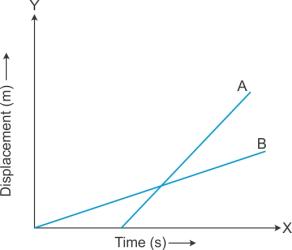
Solution 7S.
Vehicle A is moving with a faster speed because the slope of line A is more than the slope of line B.
8S.State the type of motion represented by the following sketches in Fig. 8 (a) and (b).
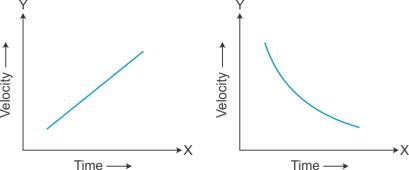
Give an example of each type of motion.

Give an example of each type of motion.
Solution 8S.
(a) Fig. 8 (a) represents uniformly accelerated motion. For example, the motion of a freely falling object.
(b) Fig. 8 (b) represents motion with variable retardation. For example, a car approaching its destination.
9S.Draw a velocity-time graph for a body moving with an initial velocity u and uniform acceleration a. Use this graph to find the distance travelled by the body in time t.
Solution 9S.
In this graph, initial velocity = u
Velocity at time t = v
Let acceleration be ‘a’
Time = t
Then, distance travelled by the body in t s = area between the v-t graph and X-axis
Or distance travelled by the body in t s = area of the trapezium OABD
= (1/2) × (sum of parallel sides) × (perpendicular distance between them)
= (1/2) × (u + v) × (t)
= (u + v)t /2
10S.What does the slope of velocity-time graph represent?
Solution 10S.
The slope of the velocity-time graph represents acceleration.
11S.Fig. 11 shows the velocity-time graphs for two cars A and B moving in the same direction. Which car has greater acceleration? Give reasons to your answer.
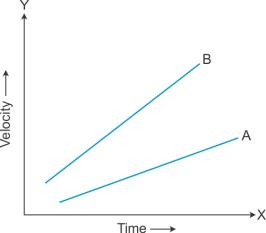

Solution 11S.
Car B has greater acceleration because the slope of line B is more than the slope of line A.
12S.The figure shows the displacement - time graph for four bodies A, B C and D. In each case state what information do you get about the acceleration (zero, positive or negative).
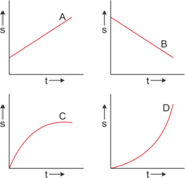

Solution 12S.
For body A: The graph is a straight line. So, the slope gives constant velocity. Hence, the acceleration for body A is zero.
For body B: The graph is a straight line. So, the slope gives constant velocity. Hence, the acceleration for body B is also zero.
For body C: The slope of the graph is decreasing with time. Hence, the acceleration is negative.
For body D: The slope of the graph is increasing with time. Hence, the acceleration is positive.
13S.Sketch the shape of the velocity-time graph for a body moving with (a) Uniform velocity and (b) Uniform acceleration.
Solution 13S.
Velocity-time for a body moving with uniform velocity and uniform acceleration.
14S.The velocity-time graph for a uniformly retarded body is a straight line inclined to the time axis with an obtuse angle. How is retardation calculated from the velocity-time graph?
Solution 14S.
Retardation is calculated by finding the negative slope.
15S.Draw a graph for acceleration against time for a uniformly accelerated motion. How can it be used to find the change in speed in a certain interval of time?
Solution 15S.
The area enclosed between the straight line and time axis for each interval of time gives the value of change in speed in that interval of time.
16S.Draw a velocity-time graph for the free fall of a body under gravity starting from rest. Take g =10m s-2
Solution 16S.
17S.How is the distance related with time for motion under uniform acceleration such as the motion of a freely falling body?
Solution 17S.
For motion under uniform acceleration, such as the motion of a freely falling body, distance is directly proportion to the square of the time.
18S.A body falls freely from a certain height. Show graphically the relation between the distance fallen and square of time. How will you determine g from this graph?
Solution 18S.
The value of acceleration due to gravity (g) can be obtained by doubling the slope of the S – t2 graph for a freely falling body.
1M.The velocity-time graph of a body in motion is a straight line inclined to the time axis. The correct statement is
1. Velocity is uniform
2. Acceleration is uniform
3. Both velocity and acceleration are uniform
4. Neither velocity nor acceleration is uniform.
Solution 1M.
2.Acceleration is uniform.
2M.For uniform motion
1. The distance-time graph is a straight line parallel to the time axis.
2. The speed-time graph is a straight line inclined to the time axis.
3. The speed-time graph is a straight line parallel to the time axis.
4. The acceleration-time graph is a straight line parallel to the time axis.
Solution 2M.
3.The speed-time graph is a straight line parallel to the time axis.
3M.For a uniformly retarded motion, the velocity-time graph is
1. A curve
2. A straight line parallel to the time axis
3. A straight line perpendicular to the time axis.
4. A straight line inclined to the time axis.
Solution 3M.1. A curve
2. A straight line parallel to the time axis
3. A straight line perpendicular to the time axis.
4. A straight line inclined to the time axis.
4.A straight line inclined to the time axis.
1N.Fig. 1N (a) shows the displacement-time graph for the motion of a body. Use it to calculate the velocity of body at t = 1 s, 2 s and 3 s, and then draw the velocity-time graph in Fig. (b) for it.

Solution 1N.
Velocity of body at t = 1s is 2 m/s
Velocity of body at t = 2s is 4 m/s
Velocity of body at t = 3s is 6 m/s
2N.The following table gives the displacement of a car at different instants of time.

(i) 2.5 s and (ii) 4.5 s?

(a) Draw the displacement-time sketch and find the average velocity of the car.
(b) What will be the displacement of the car at
Solution 2N.
Displacement-time graph
From the part AB of the graph,
Average velocity = (Displacement at B – Displacement at A)/Time taken
= (30 – 20) m/( 6 – 4) s
= (10/2) m/s
= 5 m/s
(b) (i) From the graph, the displacement of car at 2.5 s is 12.5 m.
(ii) From the graph, the displacement of car at 4.5 s is 22.5 m.
3N.A body is moving in a straight line and its displacement at various instants of time is given in the following table

Plot the displacement-time graph and calculate
(i) Total distance travelled in the interval 1 s to 5 s.
(ii) Average velocity in time interval 1 s to 5 s.
Solution 3N.
4N.In Fig. 4N, the displacement of a body is shown at different times.
(a) Calculate the velocity of the body as it moves for (i) 0 to 5 s, (ii) 5 s to 7 s and (iii) 7 s to 9 s.
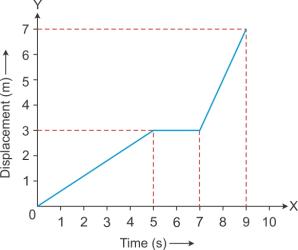
Solution 4N.
(a) (i) Velocity from 0 to 5 s = Displacement /time
= (3/5) m/s
= 0.6 m/s
(ii) Velocity from 5 s to 7 s = Displacement /time
= (0/2) m/s
= 0 m/s.
(iii) Velocity from 7 s to 9 s = Displacement /time
= (7 – 3)/(9 – 7) m/s
= (4/2) m/s
= 2 m/s
(b) From, 5 s to 9 s, displacement = 7m – 3m = 4m.
Time elapsed between 5 s to 9 s = 4 s
Average velocity = Displacement/time
= (4/4) m/s
= 1 m/s
5N.From the displacement-time graph of a cyclist given below in the Fig. 2.39, find
(i) The average velocity in the first 4 s,
(ii) The displacement from the initial position at the end of 10 s,
(iii) The time after which he reaches the starting point.
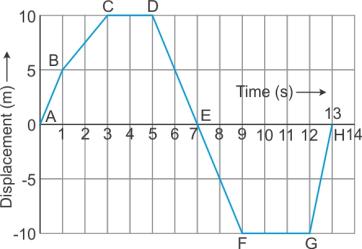
Solution 5N.
(i) Displacement in first 4s = 10 m
Therefore, the average velocity = Displacement/time
= (10/4) m/s
= 2.5 m/s
(ii) Initial position = 0 m
Final position at the end of 10 s = -10m
Displacement = Final position – Initial position
= (-10) m – 0
= -10 m
(iii) At 7 s and 13 s, the cyclist reaches his starting point.
6N.In below Fig represents the displacement-time sketch of motion of two cars A and B. Find
(i) The distance by which the car B was initially ahead of car A.
(ii) Velocities of car A and car B.
(iii) The time in which the car A catches car B.
(iv) The distance from start when the car A will catch car B.
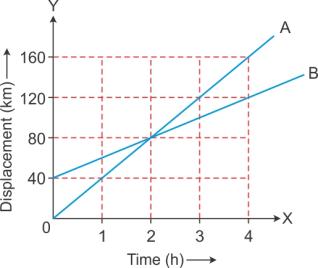
Solution 6N.
(i) Initially, the car B was 40 km ahead of car A.
(ii) Straight line depicts that cars A and B are moving with uniform velocities.
For car A
Displacement at t = 1 h is 40 m
Velocity = Displacement /time
= (40/1) km/h
= 40 km/h
For car B
Displacement at t = 4 h is (120 – 40) km, i.e. 80 km
Velocity = Displacement /time
= (80/4) km/h
= 20 km/h
(iii) Car A catches car B in 2 hours.
(iv) After starting, car A will catch car B at 80 km.
7N.
Solution 7N.
8N. Below Fig. (a) shows the velocity-time graph for the motion of a body. Use it to find the displacement of the body at t = 1 s, 2 s, 3 s and 4 s, then draw on Fig. 4.39(b), the displacement-time graph for it.
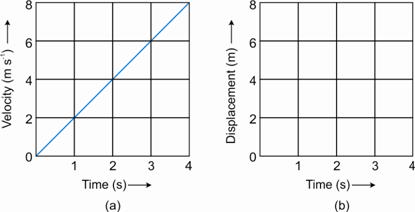

Solution 8N.
Velocity of the body at t = 1 s is 1 m/s.
Displacement of the body at t = 1 s is velocity × time = (1) × (1) m or 1 m.
Velocity of the body at t = 2s is 2 m/s.
Displacement of the body at t = 1 s is velocity × time = (2) × (2) m or 4 m.
Velocity of the body at t = 3 s is 3 m/s.
Displacement of the body at t = 3 s is velocity × time = (3) × (3) m or 9 m
9N.given below shows a velocity-time graph for a car starting from rest. The graph has three parts AB, BC and CD.
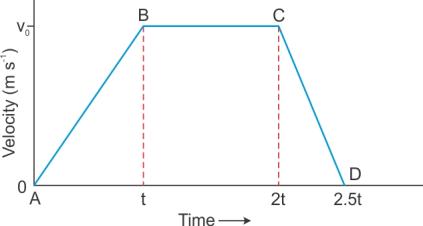
(i) State how the distance travelled in any part is determined from this graph.
(ii) Compare the distance travelled in part BC with the distance travelled in part AB.
(iii) Which part of graph shows motion with uniform (a) velocity (b) acceleration (c) retardation?
(iv) (a) Is the magnitude of acceleration higher or lower than that of retardation? Give a reasons.
(b) Compare the magnitude of acceleration and retardation.

(i) State how the distance travelled in any part is determined from this graph.
(ii) Compare the distance travelled in part BC with the distance travelled in part AB.
(iii) Which part of graph shows motion with uniform (a) velocity (b) acceleration (c) retardation?
(iv) (a) Is the magnitude of acceleration higher or lower than that of retardation? Give a reasons.
(b) Compare the magnitude of acceleration and retardation.
Solution 9N.
(i) Distance travelled in any part of the graph can be determined by finding the area enclosed by the graph in that part with the time axis.
(ii) Distance travelled in part BC = Area of the rectangle tBC2t = base × height.
= (2t – t) × vo
= vot
Distance travelled in part AB = Area of the triangle ABt
= (1/2) × base × height
= (1/2) × t × vo
= (1/2) vo t
Therefore, distance travelled in part BC:distance travelled in part AB :: 2:1.
(iii) (a) BC shows motion with uniform velocity.
(b) AB shows motion with uniform acceleration.
(c) CD shows motion with uniform retardation.
(iv) (a) The magnitude of acceleration is lower as the slope of line AB is less than that of line CD.
(b) Slope of line AB = vo/t
Slope of line CD = vo/0.5t
Slope of line AB/Slope of line CD = (vo /t)/(vo /0.5t)
Slope of line AB:Slope of line CD :: 1:2.
10N.The velocity-time graph of a moving body is given below in Fig.
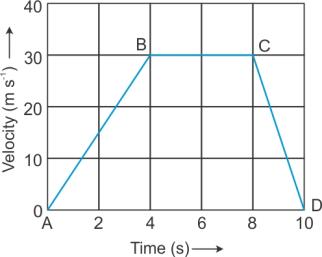
Find
(i) The acceleration in parts AB, BC and CD.
(ii) Displacement in each part AB, BC and CD.
(iii) Total displacement.
Solution 10N.
(i) Acceleration in the part AB = Slope of AB
= tan (∠BAD)
= (30/4) ms-2
= 7.5 ms-2
Acceleration in the part BC = 0 ms-2
Acceleration in the part CD = slope of CD = -tan (∠CDA)
= -(30/2) ms-2
= -15 ms-2
(ii) Displacement of part AB = Area of ΔAB4 = (1/2) (4) (30)
= 60 m
Displacement of part BC = Area of rectangle 4BC8
= (30) × (4) = 120 m
Displacement of part CD = Area of ΔC8D = (1/2) (2) (30)
= 30 m
(iii) Total displacement = Displacement of part AB + Displacement of part BC + Displacement of part CD
= 60 + 120 + 30 = 210 m
11N.A ball moves on a smooth floor in a straight line with uniform velocity 10 m s-1 for 6 s. At t = 6 s, the ball hits a wall and comes back along the same line to the starting point with the same speed. Draw the velocity-time graph and use it to find the total distance travelled by the ball and its displacement.
Solution 11N.
Distance travelled in first 6 s = velocity × time
= 10 m/s × 6
= 60 m/s
Distance travelled in next 6 s = velocity × time
= 10 m/s × 6
= 60 m/s
Total distance travelled in 12 s = (60 + 60) m = 120 m
Total displacement = 0, as the ball returns its starting point.
12N.Below Fig. shows the velocity-time graph of a particle moving in a straight line.
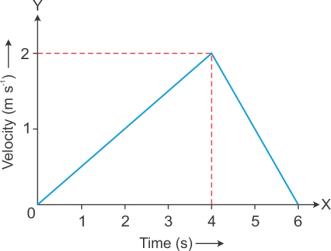
(i) State the nature of motion of particle.
(ii) Find the displacement of particle at t = 6 s.
(iii) Does the particle change its direction of motion?
(iv) Compare the distance travelled by the particle from 0 to 4 s and from 4 s to 6 s.
(v) Find the acceleration from 0 to 4 s and retardation from 4 s to 6 s.
Solution 12N.
(i) From 0 to 4 seconds, the motion is uniformly accelerated and from 4 to 6 seconds, the motion is uniformly retarded.
(ii) Displacement of the particle at 6 s = (1/2) (6) (2) = 6 m
(iii) The particle does not change its direction of motion.
(iv) Distance travelled by the particle from 0 to 4s (D1) = (1/2) (4) (2) = 4 m
Distance travelled by the particle from 4 to 6s (D2) = (1/2) (2) (2) = 2 m
D1:D2:: 4:2
D1:D2:: 2:1
(v) Acceleration from 0 to 4 s = (2/4) ms-2 or 0.5 ms-2
Retardation from 4 s to 6 s = (2/2) ms-2 or 1 ms-2.
Exercise 2(C)
Solution 1S.
Three equations of a uniformly accelerated motion are
v = u + at
s = ut + (1/2)at2
v2 = u2 + 2as
2S.Derive the following equations for uniformly accelerated motion:
(i) v = u + at
(ii) Selina Solutions Icse Class 9 Physics Chapter - Motion In One Dimension
(iii) v2 = u2 + 2aS
where the symbols have their usual meanings.
Solution 2S.
Derivation of equations of motion
First equation of motion:
Consider a particle moving along a straight line with uniform acceleration ‘a’. At t = 0, let the particle be at A and u be its initial velocity, and at t = t, let v be its final velocity.
Acceleration = Change in velocity/Time
a = (v – u)/t
at = v – u
v = u+ at … First equation of motion.
Second equation of motion:
Average velocity = Total distance traveled/Total time taken Average velocity = s/t …(1)
Average velocity can be written as (u+v)/2 Average velocity = (u+v)/2 …(2)
From equations (1) and (2) s/t = (u+v)/2 …(3)
The first equation of motion is v = u + at.
Substituting the value of v in equation (3), we get
s/t = (u + u + at)/2 s = (2u + at) t/2 = 2ut + at2/2 = 2ut/2 + at2/2
s = ut + (1/2) at2 …Second equation of motion.
Third equation of motion:
The first equation of motion is v = u + at. v – u = at … (1)
Average velocity = s/t …(2)
Average velocity =(u+v)/2 …(3)
From equation (2) and equation (3) we get,
(u + v)/2 = s/t …(4)
Multiplying eq (1) and eq (4) we get,
(v – u)(v + u) = at × (2s/t) (v – u)(v + u) = 2as
[We make the use of the identity a2 – b2 = (a + b) (a – b)]
v2 – u2 = 2as …Third equation of motion.
3S.Write an expression for the distance S covered in time t by a body which is initially at rest and starts moving with a constant acceleration a.
Solution 3S.
1M.The correct equation of motion is
1. v = u + As
2. v = ut + a
3. s = ut + (1/2) at
4. v = u + a
Solution 1M.
v = u + at
2M.A car starting from rest accelerates uniformly to acquire a speed 20 km h-1 in 30 min. The distance travelled by a car in this time interval will be
1. 600 km
2. 5 km
3. 6 km
4. 10 km
1. 600 km
2. 5 km
3. 6 km
4. 10 km
Solution 2M.
5 km
1N.A body starts from rest with uniform acceleration 2 m s-2. Find the distance covered by the body in 2 s.
Solution 1N.
Initial velocity u = 0
Acceleration a = 2 m/s2
Time t = 2 s
Let ‘S’ be the distance covered.
Using the second equation of motion,
S = ut + (1/2) at2
S = 0 + (1/2) (2) (2) 2
S = 4 m
2N.A body starts with an initial velocity of 10m s-1 and acceleration 5 m s-2. Find the distance covered by it in 5 s.
Solution 2N.
Initial velocity u = 10 m/s
Acceleration a = 5 m/s2
Time t = 5s
Let ‘S’ be the distance covered.
Using the second equation of motion,
S = ut + (1/2) at2
S = (10)(5) + (1/2) (5) (5) 2
S = 50 + 62.5
S = 112.5 m
3N.A vehicle is accelerating on a straight road. Its velocity at any instant is 30 km/h. After 2s, it is 33.6 km/h, and after further 2 s, it is 37.2 km/h. Find the acceleration of the vehicle in m s-2. Is the acceleration uniform?
Solution 3N.
Acceleration = Change in velocity/time taken
In the first two seconds,
Acceleration = [(33.6 – 30)/2] km/h2
= 1.8 km/h2
= 0.5 m/s2 …(i)
In the next two seconds,
Acceleration = [(37.2 – 33.6)/2] km/h2
= 1.8 km/h2
= 0.5 m/s2…(ii)
From (i) and (ii), we can say that the acceleration is uniform.
4N.A body, initially at rest, starts moving with a constant acceleration 2 m s-2. Calculate: (i) the velocity acquired and (ii) the distance travelled in 5 s.
Solution 4N.
Initial velocity u = 0 m/s
Acceleration a = 2 m/s2
Time t = 5 s
(i) Let ‘v’ be the final velocity.
Then, (v – u)/5 = 2
v = 10 m/s
(ii) Let ‘s’ be the distance travelled.
Using the third equation of motion,
v2 – u2 = 2as
We get,
(10) 2 – (0) 2 = 2(2) (s)
Thus, s = (100/4) m = 25 m
5N.A bullet initially moving with a velocity 20 m/s strikes a target and comes to rest after penetrating a distance 10 cm into the target. Calculate the retardation caused by the target.
Solution 5N.
Initial velocity u = 20 m/s
Final velocity v = 0
Distance travelled s = 10 cm = 0.1 m
Let acceleration be ‘a’.
Using the third equation of motion,
v2 – u2 = 2as
We get,
(0) 2 – (20) 2 = 2(a) (0.1)
a = -(400/0.2) m/s2
a = -2000 m/s2
Thus, retardation = 2000 m/s2
6N.A train moving with a velocity of 20 m s-1 is brought to rest by applying brakes in 5 s. Calculate the retardation.
Solution 6N.
Initial velocity u = 20 m/s
Final velocity v = 0
Time taken t = 5 s
Let acceleration be ‘a’.
Using the first equation of motion,
v = u + at
0 = 20 + 5a
a = -4 m/s2
Thus, retardation = 4 m/s2
7N.A train travels with a speed of 60 km h-1 from station A to station B and then comes back with a speed 80 km h-1 from station B to station A.
Find
(i) The average speed
(ii) The average velocity of the train.
Solution 7N.
Let ‘s’ be the distance between stations A and B.
(i) Average speed = Total distance/total time taken
Here, total distance = s + s = 2s
Total time taken = Time taken to travel from A to B + Time taken to travel from B to A.
= [(s/ 60) + (s/ 80)] s
= [ 140 s / 4800] s
(ii) Average velocity = Displacement/total time taken
Because the train starts and ends at the same station, the displacement is zero. Thus the average velocity is zero.
8N.A train is moving with a velocity of 90 km h-1. When the brakes are applied, retardation produced is 0.5 ms-2.
Find
(i) The velocity after 10 s
(ii) The time taken by the train to come to rest.
Solution 8N.
Initial velocity u = 90 km/h = 25 m/s
Final velocity v = 0 m/s
Acceleration a = -0.5 m/s2
(i) Let ‘V’ be the velocity after time t = 10 s
Using the first equation of motion,
v = u + at
We get,
V = 25 + (-0.5) (10) m/s
V = 25 – 5 = 20 m/s
(ii) Let t’ be the time taken by the train to come to rest.
Using the first equation of motion,
v = u + at
We get,
t’ = [(0 – 25)/ (-0.5)] s
t’ = 50 s
9N.A car travels a distance 100 m with constant acceleration and average velocity of 20 ms-1. The final velocity acquired by the car is 25 ms-1.
Find
(i) The initial velocity.
(ii) Acceleration of the car.
Solution 9N.
Distance travelled s = 100 m
Average velocity V = 20 m/s
Final velocity v = 25 m/s
(i) Let u be the initial velocity.
Average velocity = (Initial velocity + Final velocity)/2
V = (u + v)/2
20 = (u + 25)/2
u = 40 – 25 = 15 m/s
(ii) Let ‘a’ be the acceleration of the car.
Using the third equation of motion,
v2 – u2 = 2as
We get,
(25) 2 – (15) 2 = 2 (a) (100)
625 – 225 = 200 a
a = (400/200) m/s2 = 2 m/s2
10N.When brakes are applied to a bus, retardation produced is 25 cm s-2 and the bus takes 20 s to stop.
Calculate
(i) The initial velocity of the bus
(ii) The distance travelled by the bus during this time.
Solution 10N.
Final velocity v = 0
Acceleration = -25 cm/s2 or -0.25 m/s2
Time taken t = 20 s
(i) Let ‘u’ be the initial velocity.
Using the first equation of motion,
v = u + at
We get,
u = v – at
u = 0 – (-0.25)(20) = 5 m/s
(ii) Let ‘s’ be the distance travelled.
Using the third equation of motion,
v2 – u2 = 2as
We get,
(0) 2 – (5)2 = 2 (-0.25) (s)
s = (25/0.5) = 50 m.
11N.A body moves from rest with uniform acceleration and travels 270 m in 3 s. Find the velocity of the body at 10 s after the start.
Solution 11N.
Initial velocity u = 0 m/s
Distance travelled s = 270 m
Time taken to travel s distance = 3 s
Let ‘a’ be the uniform acceleration.
Using the second equation of motion,
S = ut + (1/2) at2
We get,
270 = 0 + (1/2) a (3)2
270 = 9a/2
a = 60 m/s2
Let v be the velocity of the body 10 s after the start.
Using the first equation of motion, we get
v = u + at
v = 0 + (60)(10) = 600 m/s
12N.A body moving with a constant acceleration travels the distances 3 m and 8 m, respectively in 1 s and 2 s.
Calculate:
(i) The initial velocity.
(ii) The acceleration of body.
Solution 12N.
Let the constant acceleration with which the body moves be ‘a’.
Given, the body travels distance S1 = 3 m in time t1 = 1 s.
Same body travels distance S2 = 8 m in time t2 = 2 s.
(i) Let ‘u’ be the initial velocity.
Using the second equation of motion,
S = ut + (1/2) at2
Substituting the value for S1 and S2, we get
(ii) Putting u = 2 m/s in the equation
13N.A car travels with uniform velocity of 25 m s-1 for 5 s. The brakes are then applied and the car is uniformly retarded and comes to rest in further 10 s. Find: (i) The distance which the car travels before the brakes are applied, (ii) Retardation and (iii) The distance travelled by the car after applying the brakes.
Solution 13N.
Initial velocity u = 25 m/s
Final velocity v = 0
(i) Before the brakes are applied, let S be the distance travelled.
Distance = Speed × time
S = (25) × (5) m
S = 125 m
(ii) Acceleration = (Final velocity – Initial velocity)/Time taken
= [(0 – 25)/15] ms-2
= (-5/2) ms-2
= -2.5 ms-2
Therefore, retardation = 2.5 ms-2
(iii) After applying brakes, the time taken to come to stop = 10 s
Let S’ be the distance travelled after applying the brakes.
Initial velocity u = 25 m/s
Final velocity v = 0
Using the third equation of motion,
v2 – u2 = 2as
We get,
(0) 2 – (25)2 = 2 (-2.5) (S’)
625 = 5(S’)
S’ = 125 m
14N.A space craft flying in a straight course with velocity of 75 km s-1 fires its rocket motors for 6.0 s. At the end of this time its speed is 120 km s-1 in the same direction.
Find
(i) The space craft's average acceleration while the motors were firing
(ii) The distance travelled by the space craft in the first 10 s after the rocket motors were started, the motors being in action for only 6 s.
Solution 14N.
Given, the initial velocity u = 75 km/s
Final velocity v = 120 km/s
Time taken = 6 s
(i) Acceleration = (Final velocity – Initial velocity)/time taken
= [(120 – 75)/6] kms-2
= (45/6) kms-2
= 7.5 kms-2
(ii) Distance travelled by the aircraft in the first 10 s = Distance travelled in the first 6 s + Distance travelled in the next 4 s.
Distance travelled in the first 6s (S1) = ut + (1/2) at2
(S1) = ut + (1/2) at2
(S1) = (75)(6) + (1/2) (7.5)(6)2
(S1) = 450 + 135
(S1) = 585 km
Distance travelled in the next 4 s (S2) = Speed × time
Speed at the end of 6 s is 120 km/s.
(S2) = (120) (4)
(S2) = 480 km
Thus, the distance travelled by the aircraft in the first 10 s = (S1) + (S2) = 585 + 480 = 1065 km.
15N.A space craft flying in a straight course with velocity of 75 km s-1 fires its rocket motors for 6.0 s. At the end of this time its speed is 120 km s-1 in the same direction.
Find
(i) The space craft's average acceleration while the motors were firing
(ii) The distance travelled by the space craft in the first 10 s after the rocket motors were started, the motors being in action for only 6 s.A train starts from rest and accelerates uniformly at a rate of 2 m s-2 for 10 s. It then maintains a constant speed for 200 s. The brakes are then applied and the train is uniformly retarded and comes to rest in 50 s. Find
(i) The maximum velocity reached,
(ii) The retardation in the last 50 s,
(iii) The total distance travelled,
(iv) The average velocity of the train.
Solution 15N.
(i) For the first 10 s, initial velocity u = 0
Acceleration a = 2 m/s2
Time taken t = 10 s
Let ‘v’ be the maximum velocity reached.
Using the first equation of motion
v = u + at
We get
V = (0) + (2) (10) = 20 m/s
(ii) For the last 50 s: Final velocity = 0 m/s, initial velocity = 20 m/s.
Acceleration = (Final velocity – Initial velocity)/time
= (0 – 20)/50 = -0.4 m/s2
Retardation = 0.4 m/s2
(iii) Total distance travelled = Distance travelled in the first 10 s + Distance travelled in 200 s + Distance travelled in last 50 s
Distance travelled in first 10s (s1) = ut + (1/2) at2
S1= (0) + (1/2) (2) (10)2
S1= 100 m
Distance travelled in 200s (s2) = speed × time
S2 = (20) (200) = 4000 m
Distance travelled in last 50s (s3) = ut + (1/2) at2
Here, u = 20 m/s, t = 50 s and a = -0.4 m/s2
S3= (20)(50) + (1/2) (-0.4) (50)2
S3= 1000 – 500
S3= 500 m
Therefore, total distance travelled = S1 + S2 + S3 = 100 + 4000 + 500 = 4600 m
(iv) Average velocity = Total distance travelled/total time taken
= (4600/260) m/s
= 17.69 m/s
Selina ICSE Solutions for Class 9 Physics Chapter 2 Motion in One Dimension

























